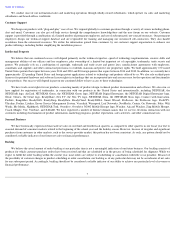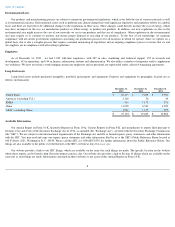Netgear 2013 Annual Report Download - page 17
Download and view the complete annual report
Please find page 17 of the 2013 Netgear annual report below. You can navigate through the pages in the report by either clicking on the pages listed below, or by using the keyword search tool below to find specific information within the annual report.
Table of Contents
Belkin, QNAP Systems, Seagate Technology, SonicWALL, Synology, TRENDnet, WatchGuard and Western Digital. Our principal competitors in the
home market for networking devices and television connectivity products include Amped Wireless, Apple, AsusTEK, Belkin, D-
Link, the Linksys line
of products under Belkin, Roku, TP-
Link and Western Digital. Our principal competitors in the broadband service provider market include Actiontec,
ARRIS, Compal Broadband, Comtrend, D-Link, Hitron, Huawei, Motorola, NetComm Wireless, Novatel Wireless, Pace, Sagem, Scientific Atlanta-
a
Cisco company, SMC Networks, TechniColor, Ubee, ZTE and ZyXEL. Other competitors include numerous local vendors such as Devolo, LEA, AVM
and the Hercules brand of Guillemot Corporation in Europe, Corega and Melco in Japan and TP-
Link in China. In addition, these local vendors may
target markets outside of their local regions and may increasingly compete with us in other regions worldwide. Our potential competitors also include
other consumer electronics vendors, including LG Electronics, Microsoft, Panasonic, Samsung, Sony, Toshiba and Vizio, who could integrate
networking and streaming capabilities into their line of products, such as televisions, set top boxes and gaming consoles, and our channel customers who
may decide to offer self-
branded networking products. We also face competition from service providers who may bundle a free networking device with
their broadband service offering, which would reduce our sales if we are not the supplier of choice to those service providers. In the service provider
space, we are also facing significant and increased competition from original design manufacturers, or ODM's, and contract manufacturers who are
selling and attempting to sell their products directly to service providers around the world. In addition, as we expand our product portfolio to include
home monitoring cameras and services, we also face competition from incumbents and specialty providers in this space, including Axis
Communications, Belkin, D-Link, the Linksys line of products under Belkin, Logitech, Dropcam, and Sercomm.
Many of our existing and potential competitors have longer operating histories, greater name recognition and substantially greater financial,
technical, sales, marketing and other resources. These competitors may, among other things, undertake more extensive marketing campaigns, adopt
more aggressive pricing policies, obtain more favorable pricing from suppliers and manufacturers, and exert more influence on sales channels than we
can. We anticipate that current and potential competitors will also intensify their efforts to penetrate our target markets. For example, price competition
is intense in our industry in certain geographical regions and product categories. Many of our competitors in the service provider and retail spaces price
their products significantly below our product costs in order to gain market share. Average sales prices have declined in the past and may again decline
in the future. These competitors may have more advanced technology, more extensive distribution channels, stronger brand names, greater access to
shelf space in retail locations, bigger promotional budgets and larger customer bases than we do. In addition, many of these competitors leverage a
broader product portfolio and offer lower pricing as part of a more comprehensive end-to-
end solution which we may not have. These companies could
devote more capital resources to develop, manufacture and market competing products than we could. Our competitors may also acquire other
companies in the market and leverage combined resources to gain market share. For example, in March 2013, Belkin completed its acquisition of the
Linksys division from Cisco. Belkin and Linksys are two of our significant competitors. The combined company may have synergies which increase
opportunities for Belkin to gain market share, especially in North America. If any of these companies are successful in competing against us, our sales
could decline, our margins could be negatively impacted and we could lose market share, any of which could seriously harm our business and results of
operations.
Economic conditions are likely to materially adversely affect our revenue and results of operations.
Our business has been and may continue to be affected by a number of factors that are beyond our control such as general geopolitical, economic
and business conditions, conditions in the financial markets, and changes in the overall demand for networking products. A severe and/or prolonged
economic downturn could adversely affect our customers' financial condition and the levels of business activity of our customers. Continued weakness
in, and uncertainty about, global economic conditions continue to cause businesses to postpone spending in response to tighter credit, negative financial
news and/or declines in income or asset values, which could have a material negative effect on the demand for networking products.
The recent indications of slow economic growth throughout various regions worldwide, especially in Europe, have presented significant challenges
to our business. For example, we believe that decreased demand in Europe adversely impacted our net revenue in all three of our business units during
fiscal 2013, relative to prior periods. If conditions in the global economy, including Europe, Australia and the United States, or other key vertical or
geographic markets continue to remain weak and uncertain or weaken even further, such conditions could have a material adverse impact on our
business, operating results and financial condition. In addition, if we are unable to successfully anticipate changing economic and political conditions,
we may be unable to effectively plan for and respond to those changes, which could materially adversely affect our business and results of operations.
In addition, the ongoing economic problems affecting the financial markets and the ongoing uncertainty in global economic conditions have
resulted in a number of adverse effects including a low level of liquidity in many financial markets, extreme volatility in credit, equity, currency and
fixed income markets, instability in the stock market and high unemployment. For example, the recent challenges faced by the European Union to
stabilize some of its member economies, such as Greece, Portugal, Spain, Hungary and even Italy, has had international implications affecting the
stability of global financial markets and hindering economies worldwide. Many member nations in the European Union have been addressing the issues
with controversial austerity
14
























